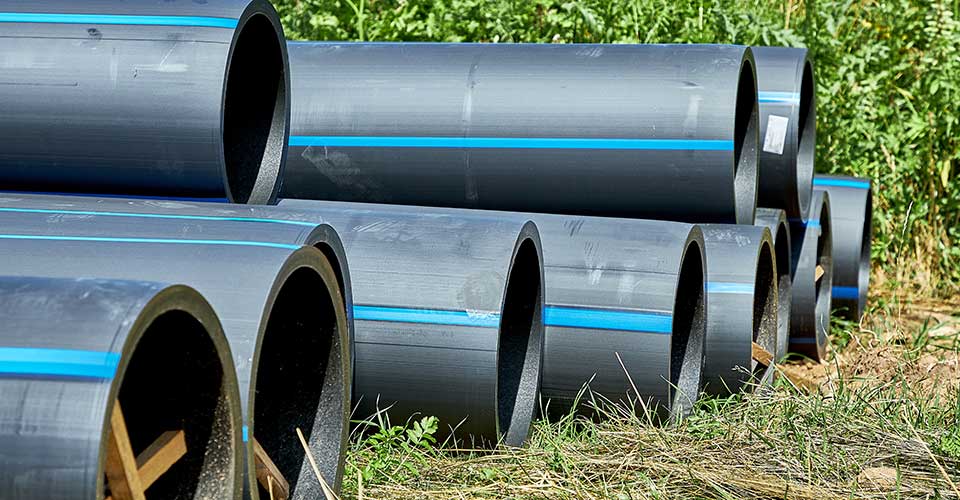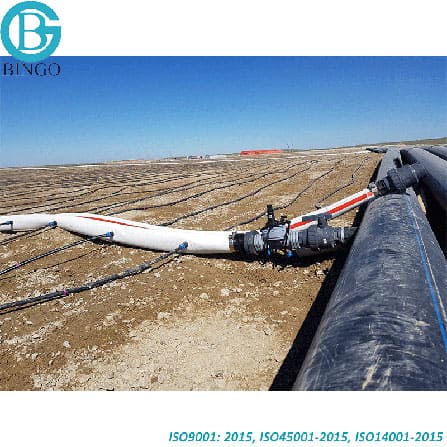How American Plastics HDPE Pipe Manufacturing Maintains High Standards
Wiki Article
Explore the Production Refine Behind High-Quality HDPE Pipe and Its Applications
The manufacturing process of high-grade HDPE pipelines is elaborate and methodical. It starts with the option of resources that boost efficiency. Following this, ethylene undergoes polymerization to form resin, which is after that formed via extrusion. Quality assurance is critical, making certain that the end product meets strict standards. However, the journey of HDPE pipes doesn't end with manufacturing. Their applications throughout different markets expose a wider relevance worth taking a look at.Recognizing HDPE: Qualities and Advantages

High-density polyethylene (HDPE) is a functional polycarbonate known for its durability and resistance to numerous environmental variables. This product shows outstanding tensile toughness, making it appropriate for requiring applications. Its low-density structure adds to a lightweight item, promoting simplicity of handling and setup. HDPE additionally showcases exceptional resistance to chemicals, which minimizes degradation when subjected to extreme materials.
The product's low wetness absorption additionally boosts its long life, making it optimal for use in pipes and tank. In addition, HDPE is resistant to ultraviolet (UV) radiation, making certain that products preserve their honesty even when revealed to sunshine. Furthermore, its adaptability enables for the production of elaborate shapes without compromising stamina. The environment-friendly nature of HDPE, often derived from recycled materials, contributes to its allure, advertising lasting practices in manufacturing. On the whole, these buildings and benefits make HDPE a favored choice for different industrial and consumer applications.
Basic Material Selection for HDPE Production
The choice of raw products for HDPE manufacturing is necessary to confirm the end product meets the preferred requirements and quality criteria. High-density polyethylene (HDPE) is primarily generated from polymerized ethylene, originated from fossil fuels such as gas or unrefined oil. The high quality of these feedstocks significantly influences the mechanical and thermal buildings of the final HDPE.Ingredients likewise play a considerable role in enhancing HDPE's efficiency, including antioxidants, UV stabilizers, and colorants, which boost durability and resistance to ecological variables. The option procedure need to consider not just the chemical make-up of the raw products but likewise their handling attributes to guarantee efficient production.
In addition, the sourcing of resources ought to prioritize sustainability and compliance with ecological guidelines, as accountable methods are essential in today's market. Eventually, mindful basic material selection lays the structure for generating high-quality HDPE pipelines suitable for varied applications.
The Extrusion Process: Forming HDPE Pipeline
The extrusion process plays a crucial function fit HDPE pipelines, beginning with meticulous product prep work methods that guarantee excellent circulation and consistency. Equally crucial is the style of the die, which straight affects the final dimensions and surface area high quality of the pipe. With each other, these variables contribute substantially to the efficiency and high quality of HDPE pipeline manufacturing.Material Preparation Strategies
Effective manufacturing of HDPE pipes begins with meticulous material prep work methods, specifically the extrusion process. Throughout this phase, high-density polyethylene resin is very first dried to get rid of wetness, ensuring ideal flow characteristics. The resin is then fed right into the extruder, where it goes through heating and melting, changing right into a viscous state. This home heating process is meticulously controlled to maintain the product's stability and performance. The liquified HDPE is compelled through a die, shaping it right into a continual pipe form. Correct temperature level administration during extrusion is vital, as it directly influences the product's properties and the final item high quality. When formed, the HDPE pipeline is cooled down and reduced to specified lengths, ready for succeeding processing and applications.Die Design Value
Accuracy in die design plays a vital function in the extrusion process of HDPE pipelines. The die acts as the last shaping device, straight influencing the pipeline's dimensions, wall density, and surface area finish. A well-designed die guarantees consistent product flow, reducing issues such as irregularities and vulnerable points. The geometry of the die have to be enhanced to accommodate the details residential properties of HDPE, including its viscosity and thermal behavior throughout extrusion. Additionally, the cooling price of the material as it passes through the die can considerably impact the pipeline's architectural stability. As a result, buying sophisticated die technology is crucial for producers aiming to generate top notch HDPE pipes that meet sector criteria and consumer expectations.Quality Assurance Procedures in HDPE Production
Various aspects influence the quality of HDPE pipeline production, reliable quality control actions are critical to ensure uniformity and dependability in the final item (American Plastics HDPE Pipe for Oilfield). Trick quality assurance methods include extensive product inspection, validating that the raw polyethylene meets recognized criteria for purity and thickness. Throughout the extrusion procedure, parameters such as temperature level, pressure, and cooling time are very closely kept an eye on to preserve dimensional precision and structural integrityIn enhancement, post-production testing is important; suppliers frequently conduct hydrostatic examinations to examine the pipe's strength and resistance to pressure. Visual assessments for surface issues better enhance high quality guarantee. Certification from appropriate standards organizations, like ASTM or ISO, supplies an added layer of reliability. By carrying out these extensive quality control actions, producers can decrease problems, boost efficiency, and make certain that the HDPE pipes fulfill the details requirements of different applications, inevitably causing client fulfillment and trust in the item.
Applications of HDPE Pipeline Across Industries
HDPE pipes are made use of across different industries because of their resilience and convenience. In water distribution systems, they ensure efficient shipment, while in wastewater monitoring, they offer reputable options for waste transport. Additionally, agricultural irrigation networks benefit from HDPE's resistance to rust and adaptability, making it a perfect choice for modern-day farming practices.
Water Circulation Equipments
A substantial number of sectors depend on high-density polyethylene (HDPE) pipelines for reliable water circulation systems. Known for their sturdiness and resistance to corrosion, HDPE pipelines are extensively utilized in community water system networks, farming watering, and commercial applications. Their lightweight nature promotes simple handling and setup, lowering labor expenses and time. In addition, HDPE pipes can accommodate various stress degrees, making them appropriate for both low and high-pressure systems. Pipe Manufacturing Midland TX. The flexibility of the material permits smooth assimilation right into existing infrastructure, reducing the need for substantial excavation. HDPE's resistance to chemical seeping guarantees that the water supplied remains secure and clean, making it an excellent option for maintaining the top quality of drinkable water across numerous sectors.Wastewater Management Solutions
Reliable water circulation systems likewise lead the way for innovative wastewater monitoring options, where high-density polyethylene (HDPE) pipes play a considerable role. Prominent for their durability and resistance to corrosion, HDPE pipelines are suitable for moving wastewater in different setups. Their flexibility allows for very easy setup in intricate settings, decreasing the demand for extensive excavation. Additionally, HDPE's smooth interior surface lowers friction, improving circulation prices and effectiveness. These pipes are also resistant to chemical leaching, making certain that contaminants do not jeopardize the surrounding atmosphere. Industries, communities, and treatment facilities progressively rely upon HDPE pipelines for their integrity and long life, making them a recommended choice for modern wastewater monitoring systems. This adaptability highlights the vital value of HDPE pipes across many applications.Agricultural Watering Networks
Agricultural irrigation networks benefit significantly from the usage of high-density polyethylene (HDPE) pipelines, which provide efficient and reputable water shipment to crops. HDPE pipes are light-weight, making them easy to carry and install, while their flexibility enables for different setups in diverse surfaces. These pipes show outstanding resistance to deterioration, chemicals, and UV radiation, ensuring resilience in rough farming settings. In addition, their smooth interior surface area decreases rubbing loss, enhancing water read more flow and reducing power costs connected with pumping. The longevity of HDPE pipes, typically surpassing 50 years, adds to decrease upkeep and substitute costs. As a result, farmers significantly rely upon HDPE pipelines to boost irrigation efficiency and promote lasting agricultural practices, inevitably leading to improved crop returns and source conservation.Future Fads in HDPE Pipe Innovation
As the need for sustainable and effective infrastructure expands, developments in HDPE pipe innovation are positioned to transform various industries. Arising fads include the integration of smart innovations, such as sensing units and IoT abilities, which help with real-time surveillance of pipe problems, reducing maintenance costs and avoiding leaks. Furthermore, the advancement of advanced production techniques, such as 3D printing, is enabling the manufacturing of complicated, tailored pipe styles that deal with specific job requirements.In addition, the focus on recycling and round economy practices is driving the development of HDPE pipes made from recycled materials, boosting sustainability. Enhanced jointing methods, such as electro-fusion and mechanical installations, are additionally enhancing installation effectiveness and reliability. Ultimately, the expanding focus on ecological laws is pressing suppliers to embrace greener manufacturing procedures, ensuring that HDPE pipelines not only fulfill sector criteria however likewise promote a more sustainable future for infrastructure development.
Regularly Asked Concerns
How Does HDPE Compare to Various Other Plastic Products?
HDPE outshines several other plastic products concerning sturdiness, chemical resistance, and flexibility. Its reduced thickness and high tensile stamina make it perfect for numerous applications, commonly exceeding choices in both performance and durability.What Are the Ecological Effects of HDPE Production?
The ecological effects of HDPE production consist of greenhouse gas exhausts, energy intake, and prospective air pollution from making processes. Furthermore, inappropriate disposal can result in soil and water contamination, increasing issues regarding lasting environmental effects.Can HDPE Pipes Be Recycled?
Yes, HDPE pipes can be recycled. Several centers approve made use of HDPE for processing, transforming it right into new products. This reusing contributes to sustainability efforts, reducing plastic waste while preserving sources and energy in the production cycle.What Is the Life Expectancy of HDPE Piping?

How Do Temperature Level Variants Impact HDPE Pipe Performance?
Temperature level variants substantially affect HDPE pipe performance, affecting flexibility and toughness. High temperature levels can bring about softening, while reduced temperatures may create brittleness, ultimately influencing the pipe's longevity and suitability for various applications in varied settings.Report this wiki page